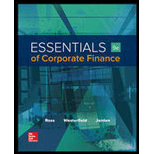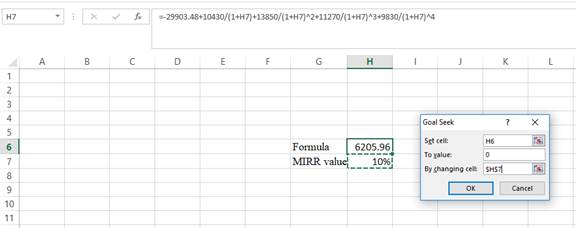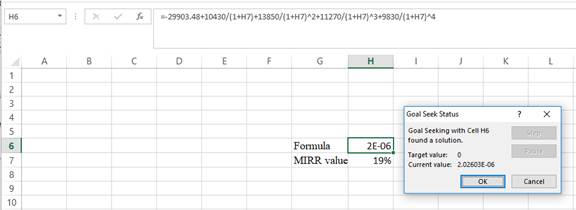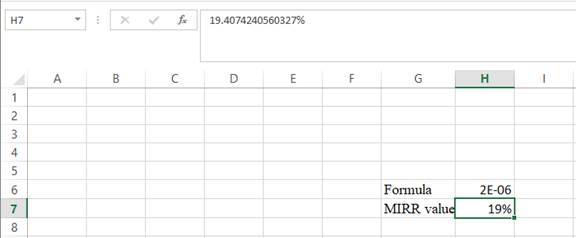
Concept explainers
MIRR. Suppose the company in the previous problem uses a discount rate of 11 percent and a reinvestment rate of 8 percent on all of its projects. Calculate the MIRR of the project using all three methods with these rates.
To calculate: The MIRR (Modified Internal Rate of Return) for the project utilizing all three methods at a rate of discount and rate of reinvestment of 11% and 8% respectively.
Introduction:
MIRR is the Modified Internal Rate of Return which is a financial measure of attracting the investments. It is utilized in capital budgeting to rank the alternative investments of the same size.
Answer to Problem 23QP
The MIRR for the project using the discounted approach is 19.41%, reinvestment approach is 13.30%, and combination approach is 13.12%.
Explanation of Solution
Given information:
Company M is assessing a project where the cash flows are $10,430, $13,850, $11,270, $9,830, and -$4,050 for year 1, 2, 3, 4, and 5 respectively. The initial cost is $27,500. The rate of discount and the rate of reinvestment are 11% and 8% respectively.
Discounted approach:
In this approach, compute the negative cash outflows value at year 0. On the other hand, the positive cash flows remain at its time of occurrence. Hence, discount the cash outflows to year 0.
Hence, the discounted cash flow at time 0 is -$29,903.48.
Equation of MIRR in discounted approach:
Compute MIRR using a spreadsheet:
Step 1:

- Type the equation of NPV in H6 in the spreadsheet and consider the MIRR value as H7.
Step 2:

- Assume the MIRR value as 10%.
Step 3:

- In the spreadsheet, go to data and select the what-if analysis.
- In the what-if analysis, select goal seek.
- In set cell, select H6 (the formula).
- The “To value” is considered as 0 (the assumption value for NPV).
- The H7 cell is selected for the by changing cell.
Step 4:

- Following the previous step click OK in the goal seek. The goal seek status appears with the MIRR value.
Step 5:

- Thevalue appears to be 19.4074240560327%.
Hence, the MIRR value is 19.41%.
Reinvestment approach:
In this approach, compute the future value of all the cash flows excluding the initial cost at the closure of the project. Hence, compute the reinvesting cash flows to year 5 is:
Hence, the reinvesting cash flow at time 5 is $51,348.64.
Equation of MIRR in reinvestment approach:
Compute the MIRR:
Hence, the MIRR is 13.30%.
Combination approach:
In this approach, compute all the cash outflows at year 0 and all the cash inflows at the closure of the project. Hence, the value of the cash flows is as follows:
Hence, the total cash outflow at year 0 is -$29,903.48.
Hence, the value of total cash inflows is $55,398.64.
Equation of MIRR in combination approach:
Compute the MIRR:
Hence, the MIRR is 13.12%.
Want to see more full solutions like this?
Chapter 8 Solutions
ESSENTIALS CORPORATE FINANCE + CNCT A.
- Lindsay is 30 years old and has a new job in web development. She wants to make sure that she is financially sound by the age of 55, so she plans to invest the same amount into a retirement account at the end of every year for the next 25 years. (a) Construct a data table in Excel that will show Lindsay the balance of her retirement account for various levels of annual investment and return. If Lindsay invests $10,000 at return of 6%, what would be the balance at the end of the 25th year? Note that because Lindsay invests at the end of the year, there is no interest earned on the contribution for the year in which she contributes. Round your answer to a whole dollar amount. $ (b) Develop a two-way table for annual investment amounts of $5,000 to $20,000 in increments of $1,000 and for returns of 0% to 12% in increments of 1%. From the 2-way table, what are the minimum annual investments Lindsay must contribute for annual rates ranging from 6% to 11%, if she wants to…arrow_forwardDoes Airbnb have any impaired assets? If so, what are they?arrow_forward1. Consider two assets with the following returns: State Prob. of state R1 R2 1 2/3 .03 .05 2 1/3 .09 .02arrow_forward
- Bright wood! Seating sells reclining chairs for $55.00 per unit. The variable cost is 322 per unit. Each reclining chair requires 5 direct labor hours and 3 machine hours to produce. ibution margin pemachine hon Wrightwood Manufacturing has a break-even point of 1,500 units. The sales price per unit is $18. and the variable cost per us $13. If the company sells 3,500 units, what will its net income be? Crestwood Industries provides the following budget data for its Processing Department for the year 2022: ⚫ Manufacturing Overhead Costs=250 ⚫ Direct Labor Costs $1,234,500 Determine the manufacturing overhead application rate under the base of Direct Labor Costs. Modesto Accessories manufactures two types of wallets leather and canvas. The company allocates manufacturing overhead using a single plant wide rate with direct labor cost as the allocation base. $48 Estimated Overhead Costs = 30,600 Direct Labor Cost per Leather Wallet Direct Labor Cost per Canvas Wallet = $52 Number of…arrow_forwardNo Aiarrow_forwardNo aiarrow_forward
- List and discuss the various values for bonds discussed in the chapter. Additionally, explain in detail what is meant by "Yield to Maturity".arrow_forwardProvide Answer of This Financial Accounting Question And Please Don't Use Ai Becouse In all Ai give Wrong Answer. And Provide All Question Answer If you will use AI will give unhelpful.arrow_forwardYou plan to save $X per year for 6 years, with your first savings contribution in 1 year. You and your heirs then plan to withdraw $43,246 per year forever, with your first withdrawal expected in 7 years. What is X if the expected return per year is 18.15 percent per year? Input instructions: Round your answer to the nearest dollar. 59 $arrow_forward
- Are there assets for which a value might be considered to be hard to determine?arrow_forwardYou plan to save $X per year for 7 years, with your first savings contribution in 1 year. You and your heirs then plan to make annual withdrawals forever, with your first withdrawal expected in 8 years. The first withdrawal is expected to be $43,596 and all subsequent withdrawals are expected to increase annually by 1.84 percent forever. What is X if the expected return per year is 11.34 percent per year? Input instructions: Round your answer to the nearest dollar. $arrow_forwardYou plan to save $41,274 per year for 4 years, with your first savings contribution later today. You then plan to make X withdrawals of $41,502 per year, with your first withdrawal expected in 4 years. What is X if the expected return per year is 8.28 percent per year? Input instructions: Round your answer to at least 2 decimal places.arrow_forward
 EBK CONTEMPORARY FINANCIAL MANAGEMENTFinanceISBN:9781337514835Author:MOYERPublisher:CENGAGE LEARNING - CONSIGNMENT
EBK CONTEMPORARY FINANCIAL MANAGEMENTFinanceISBN:9781337514835Author:MOYERPublisher:CENGAGE LEARNING - CONSIGNMENT
